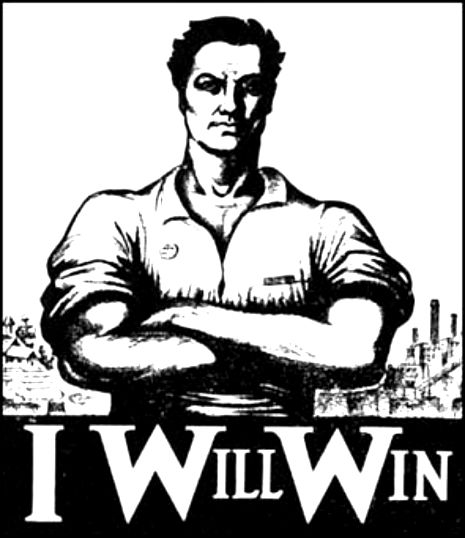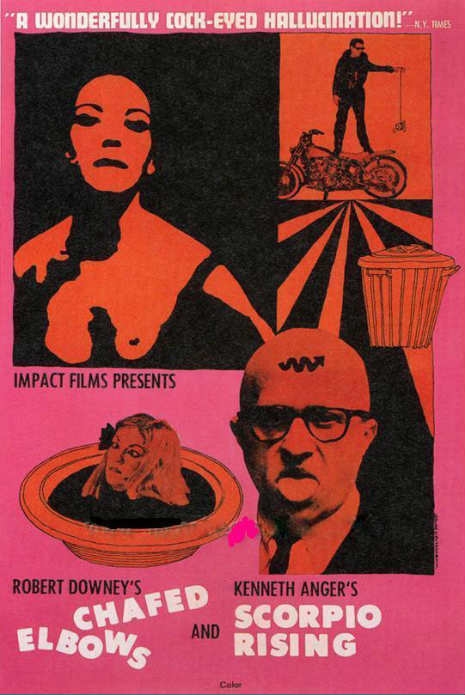
This is a guest editorial from Dangerous Minds reader Em, expanding on some pointed commentary he’s made elsewhere on this blog. Em—who’ll keep his last name to himself, thank you very much—works in the financial industry.
Many commentators have attempted to draw parallels between the Egyptian protestors in Tahriri square and the protestors in Wisconsin’s state capital, where the republican governer Walker has introduced legislation that would (among other things) remove the right of state workers to collectively bargain. Such commentators have done a better or worse job, but in any event didn’t appear all that convinced by what they had written, despite the feeling that there at least seemed to be similarities that could not be explained by coincidence alone. Of course, the protestors in Egypt are largely (but not exclusively) Muslim, and live in a developing economy that has never experienced first-world standards of living, while the Wisconsin protestors are predominantly white and hail from families that have experienced first-world standards of living for several generations. It would appear, therefore, that any similarities are superficial and any comparison between the two groups more poetic rather than substantive.
What the protestors in Tahriri Square as well as the public Union workers in Winsconsin have in common is the rejection of a commonly repeated narrative about how wealth is created. In this commonly repeated narrative, it is necessary to concentrate capital in the hands of a few, who will then use that capital to create businesses and generate wealth, which will trickle down to the many. In order to get this alleged wealth-pump moving, impediments to wealth concentration such as labor movements must be removed, and indeed (according to the common false narrative), the history of wealth generation in developed countries such as the USA is precisely the history of overcoming these pesky impediments. What the protestors in both Wisconsin as well as the Arab world have done is reject that narrative as well as the bogus and half-baked economic theory that is often sold as part of it.
A corrollary to this theory of wealth generation is that civil liberties such as free speech are a luxury, and should be suspended for the sake of the greater good, until wealth starts to flow and incomes rise significantly. This is a particularly pernicious part of the package, because no doubt countless men and women workers have resigned themselves to a life of incredible toil in order to (they believe) move their society forward. Inequities, injustices as well as the suspension of civil liberties were tolerated because they appeared necessary to move their country ahead into greater levels of wealth for everyone.
What the third world protestors in Tahriri Square and elsewhere in the Arab world have done, along with their compatriots in the Wisconsin State Capital, is reject this set of lies and the false either/or choice it presents of civil liberty versus economic progress. Though they may not be able to articulate it, the protestors have finally looked upon the general character of those that hold the levers of power and chose to regard the false choice they have proferred as a lie, which it is.
The first part of this larger-scale lie is that Labor has played no significant role in the generation of wealth in the developed world. In fact, empowering workers has been equated with command-driven soviet and communist models, which were arguably equitable by making everyone equally poor. In this narrative, the US has generated its unprecedented wealth precisely by defeating the evil specter of organized labor. Wealth, it is told, has been created by allowing capital to be concentrated into the hands of the wealthy, who best know how to wield it, thereby creating jobs and new wealth. What is not stated in this view is that the wealthy classes are regarded as almost a divine class, having been born (and not made) and appointed by God.
The reality, of course, is different. In developed economies, the vast majority of wealth has been created in the last hundred years or so. Scratch any millionare and you will see someone with fairly working-class roots, though perhaps it’s necessary to go back a generation or two. But the point is that wealthy individuals and families were not always wealthy, but got that way through a combination of risk-taking, hard work, capital investment, and luck. In other words, wealthy people were made and not born, and accumulated their wealth initially as members of the working class.
That wealthy people are the primary engine of job creation is demonstrably false, the evidence of which is readily found in the results of Bush’s tax cuts. The argument from the so-called right continues to be that, in placing more capital in the hands of the wealthy, jobs will be created and wealth will flow down and tax revenues will necessarily increase. However, the reality is the opposite: the fact that Bush’s tax cuts left Barack Obama with a significant deficit (even prior to the bank bailouts) is proof that this idea is at best flawed and at worst a lie: Jobs and wealth are not created by the few but, rather, by the many. This suggests that America’s Labor Union movement of the early 20th century may have been responsible for a large percentage of wealth generation, in that it placed an unprecedented abundance of capital into the hands of the middle class.
An interesting set of facts to examine is how certain pro-labor developed economies have performed during the 2008 fiscal crisis. Looking at two of Europe’s most labor-dominated economies, Sweden and Germany, we find that these two countries fared far better than most other european economies that had far less enrollment in labor unions. Although Germany (with 26% union enrollment) has taken on an approximately 4.5% deficit (compared to GDP), it has done so in order to come to the aid of Greece and other troubled economies in the EEU, while planning to return to the black by 2012. Sweden (at approximately 75% union enrollment), likewise, has deliberately taken on a temporary deficit in order to assist with the bailout of Iceland. It would appear, therefore, that the countries with some of the heaviest union pariticpation in the world sailed through the fiscal crisis with nary a scratch. The conclusion is that the working classes in these countries actually contributed significantly to economic stability and growth, and that the labor movements therein allowed capital to be placed into the hands of many, resulting in the generation of real economic growth and wealth.
Meanwhile, in the US, we have the opposite: Falling union enrollment and huge budgetary deficits incurred during the fiscal crisis. Given the budgetary deficits that existed as a result of the Bush tax cuts, is it still reasonable to conclude that placing more capital into the hands of the wealthy will actually result in additional job creation? The circumstantial evidence says no, but a deeper analysis reveals that such an assumption may have actually brought about the fiscal collapse itself.
As union enrollment collapsed in the US and real wages declined, capital fled the middle class which therefore also lost the ability to generate new small-to-medium-sized businesses. Partially as a result of weakened labor, both manufacturing as well as service jobs were moved overseas thus further depleting capital resources from the middle class along with job creation. As capital concentrated into the hands of the wealthy (who had no place to put it), they sought new opportunities and found them in the form of tthe American dream: Home ownership. Because real economic growth was rapidly draining out of the middle class, Wall Street stepped up to the plate and created new financial instruments designed to allow the wealthy to invest in what would have otherwise been very risky deals. Through the creation of a whole plethora of derivative securities (such as Collateralized Debt Obligations), the underlying riskiness of the ‘sub-prime’ housing market was in effect trapped and tamed, thereby allowing fund managers to invest in double-A rated securities magically derived from large groups of underlaying risky mortgages.
An obvious and inherent problem in this risky housing market was that it was essentially a big game of musical chairs: I would borrow money to buy your house, while you borrowed money to buy mine. We now had houses that were worth more than we bought them for, so we did it again. And again. And again. If this feels unreasonable and like a perpetual motion machine, you are correct: this couldn’t continue, and it didn’t. As for those AA-rated CDOs, they fell apart as they had not been stress-tested for scenarios like, well, reality. On Wall Street no one had wanted to know what the real risks were, because Basel II rules would have required the banks to hold far large amounts of capital in reserve, making the CDOs and other derivatives not worth the risk.
In a sense, then, it could be argued that the failure of the banking system was caused directly by the flight of capital away from the working and labor classes, and due to the overconcentration of capital in the hands of the wealthy few, who did not know what else to do with it. An unregulated Wall Street did exactly what it was supposed to do (create new investment vehicles that direct capital at new opportunities), and any dissenting CEO would be quickly replaced.
One important conclusion to draw from this is that, by empowering workers and trade unions, capital is placed into the hands of the many and, through this means, new wealth is generated. The idea that strong labor merely communistically disperses capital (thereby making everyone poor) is a lie. Of course, the demise of the Soviet Union and larger-scale failure of command economies tempts one to believe that labor is somehow an enemy to wealth, but this is simply untrue and is an untruth that has been weaved into a strategy of divide-and-conquer as well the suspension of civil liberties.
Wisconsin is similar to Tahriri Square in that the vast majority of working people have recognized that the commonly-chanted narrative of organized labor as enemy of wealth is a lie. In both cases, the People have recognized that the choices being offered are not the only choices, and that the suspension of civil liberties actually means the continued poverty of most, while a small number of extremely wealthy people look for ways to utilize their uselessly huge piles of capital. If this is the case, then why sacrifice freedom of speech or the right to assemble or collectively bargain? All this can do is needlessly continue suffering while strengthening the State, which gets drafted into serving a small minority. It is that minority that believes that wealth is a zero sum game, even though it isn’t, and that empowering others necessarily means a loss of wealth for ones’ self, even though it is precisely through the widespread availability of capital that new wealth is created.
About the author: Em was a founding member (with John Cale and others) of the New York punk band Doppler Effect in the early 1980s. After living in China in the late 80s, Em worked in the physics and electrical engineering space until 2002, at which time he moved into the financial world. In July, Em returned to the US after having lived in London since 2006 and is a member of the UMOUR art/event collective. He blogs at The Magic Lantern, his"litterbox of the soul.”













